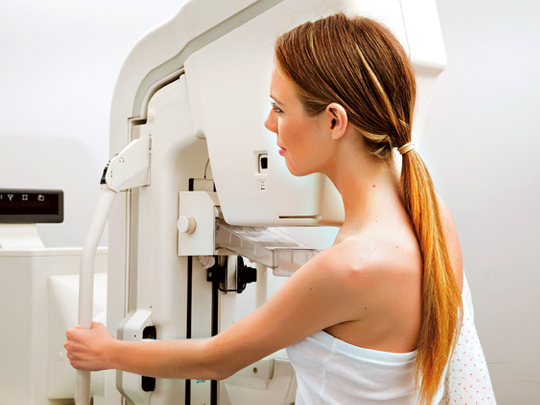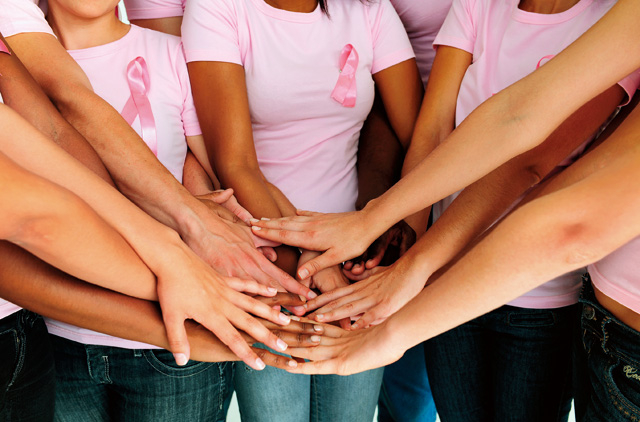
Three years ago, I wrote a feature on breast cancer. At that time, to better understand the subject (and to overcome personal fears), I had a mammogram and consulted an oncologist.
My report was inconclusive, but I was told I had a clean bill of health because I was nowhere close to the high-risk age bracket, and I didn't have a history of breast cancer in my family. I was told to return for a test two years later.
That, however, did not happen because it completely slipped my mind until I began to experience breast pain a few months ago.
My initial deduction was that it had to do with acidity. But when it recurred a few weeks later and with a lot more intensity leaving my face contorted with pain, I remembered the test. I did a quick self-examination and found a well-defined lump I hadn't felt before. I was a bit edgy but kept my fear under wraps. A month later I noticed that the pain was getting severe. It was random. I was scared. A few weeks later, I realised I was losing weight. Reluctant to keep it a secret any longer I told my family and made an appointment with my doctor.
This time, the doctor skipped the mammogram because I had already done one and did an ultrasound scan which revealed two cysts. The doctor called it a honeycomb cyst.
This jolted me into action. Keen to have a better understanding of my condition, I made an appointment with Dr Ritu Khare, Special Laproscopy Surgeon at The Dubai Mall Medical Centre.
A specialist in breast surgeries, Dr Khare has more than a decade of experience in the field. After reviewing my report she concluded that the findings were not disturbing. The cysts had come together to form one mass so the pressure was great. That was what was causing the pain. But it was a benign cyst and not one that becomes malignant, the doctor told me.
She prescribed a course of medication for six months and advised me to return for a follow-up in a few months.
I called up a friend and while giving her the update on my condition, I realised that I was not alone. She told me about a few of her friends who had experienced breast pain. Many of them were still confused about their problem and were not sure what the various terms meant.
That got me thinking.
I made another appointment with Dr Khare to gain a better understanding of breast pain. I wanted to share what I had learned - the causes, what can be done when you are given non-conclusive mammogram or ultrasound results and the role of genetics in breast cancer.
Excerpts from the interview with Dr Khare:
Why do women experience breast pain?
Breast pain is a very common symptom. There are usually two types - cyclical and non-cyclical. Cyclical pain occurs because of the fluctuation in the hormone levels in the body during or prior to the menstrual cycle. A spike in the oestrogen levels can lead to fluid accumulation in the breast leaving it feeling heavy and sensitive. Women may find it difficult to lift or move moderately heavy objects, wear tight clothes or do any kind of exercise during this time. The pain subsides with the onset of menstruation. Not all women experience this and it has no risk associated with cancer but is more of a nuisance factor.
Non-cyclical pain is what worries women. It can occur at any time, is very sharp and piercing at times. Most of the times it may not be related to the condition of the breast. In elderly women it is prudent to rule out heart or lung problems before providing symptomatic treatment. This pain may be related to cysts or lumps and should definitely be investigated further by a doctor.
What is the treatment for cyclical breast pain?
First, don't worry. Understand your body's rhythm and cycle. Wear good breast support, drink a little less fluid to avoid retention and avoid underwire bras as the metal can dig into the tissue and increase the pain. Wear a sports bra when exercising. Use over-the-counter pain killers to deal with the pain. A simple hot fomentation or applying an anti-inflammatory gels helps.
What are breast cysts?
Cysts are usually benign lumps formed in the breast due to the effect of certain hormones or due to fluid accumulation. The fluid that accumulates in the breast prior to the menstrual cycle is usually re-absorbed. Sometimes, however, a localised pocket of fluid is left behind, which forms a cyst. Most cysts are small, but if they become bigger they can be extremely painful.
Are cysts associated with cancer?
Cysts themselves are not found to be associated with an increased risk of cancer except for a very small (0.1) percentage. But what is more important is that the follow-up of these patients is made a bit more rigorous. There are various reasons for that. A patient with a cancerous cyst may not experience pain. Also, the symptoms of a cancerous cyst can sometimes be similar to one that is benign. Another reason is that the mammogram findings in these patients can suggest a dense breast in which the smaller lesions are hidden. So the mammogram screening becomes ineffective as the radiologist reports that the mammogram "cannot comment conclusively". Such patients need to be more conscious of changes happening to them and require alternative screening measures for a conclusive diagnosis.
Are most breast lumps malignant?
Eighty per cent of lumps in the breast are benign. They may be cysts, fibrosis, pseudo lumps or fibroadenoma. But if you find a lump in your breast it calls for a proper evaluation. You need to visit the doctor and she should be able to come to a definite conclusion based on radiology and biopsy reports (if required). If the lump is more than 1.5-2 cm in size and solid in consistency, it is advisable to remove it surgically. Smaller lumps can be followed up on a regular basis.
What does discharge from the breasts indicate?
It is important to know the age of the patient age and the associated symptoms. Milky discharge at a young age is predominantly due to hormonal issues. Sometimes a duct in the breast could get partially blocked resulting in the secretion collecting behind the blockage and becoming infected. In some cases there is a swelling of the glands of the duct forming a papilloma, which may cause a blood-stained discharge. Any staining of a garment by discharge should be taken seriously and you should get yourself checked by a doctor as soon as possible.
What types of tests are done for breast ailments?
One of the tests done is a sonomammo. Ultrasonography and mammograms also study the breast. They are complementary as individually each may not be able to provide complete information. An ultrasound scan will reveal the nature of the lump (solid or cystic), while the mammogram will show the presence of any suspicious characteristics.
Why is a mammogram not advised for young women?
At a young age, the breast tissue is very dense and the mammogram could fail to pick up small lumps which could be hidden behind the dense gland resulting in a false negative result.
What are the newer methods of screening?
- Digital enhanced mammogram
- MRI of the breast
What should you be aware of when going for a mammogram?
You should be able to get answers to these basic questions:
- Does a trained and qualified radiologist report the mammogram?
- Has your mammogram screening been seen by a surgeon who has done your clinical examination as well? l Will the centre call you when the report is ready or should you call them to find out?
- Will they provide you with the digital recording/films, which will help to compare later with new findings?
- What is your Birads (Breast Imaging-Reporting and Data System) category? Birads is a quality assurance tool originally designed for use with mammography.
- What are you expected to do once you have the report and Birads category? Remember Birads zero is not the best. It just says that your study is not complete. It means you need to understand and clarify with your doctor what further steps need to be taken. All women should be aware of changes in their body. They are their own judges. One should be able to identify any variation from the ‘normal' and report it to the doctor. If you have any doubts, visit a gynaecologist who will refer you to a surgeon.
What is the role of genetics in breast cancer?
Breast cancer is sometimes transmitted through a gene; the mutation of these genes may result in the onset of breast cancer. There are tests available, which can help to detect this mutated gene in your DNA.
What do we mean by the term ‘genetic testing' in the case of breast cancer?
Genetic testing is done for specific genes that are linked to breast cancer. The names BRCA1 and BRCA2 stand for breast cancer susceptibility gene 1 and breast cancer susceptibility gene 2, respectively.
In normal cells, BRCA1 and BRCA2 help ensure the stability of the cell's genetic material (DNA) and help prevent uncontrolled cell growth. Mutation of these genes has been linked to the development of hereditary breast and ovarian cancer.
What happens if you inherit these genes?
A woman's lifetime risk of developing breast and/or ovarian cancer is greatly increased if she inherits a harmful mutation in BRCA1 or BRCA2. Such a woman has an increased risk of developing breast and/or ovarian cancer at an early age (before menopause) and often has multiple close family members who have been diagnosed with these diseases.
A woman who has inherited a harmful mutation is about five times more likely to develop breast cancer than a woman who has not. That said, not all women who inherit the genes go on to develop breast cancer. Between 15-20 per cent will actually not develop breast cancer.
Are genetic tests available to detect BRCA1 and BRCA2 mutations? How are they performed?
Yes, they are readily available. It is a kind of blood test where the DNA is tested for the presence of mutated genes or the serum is tested for proteins produced by the altered genes or a combination of both. These tests are expensive and take a little longer to be reported.
Before a person undergoes the test, she needs to undergo thorough genetic counselling to understand the implications of the results.
Who should undergo genetic testing?
- Women in a family with a history of breast and/or ovarian cancer. It may be most informative to first test a family member who has breast or ovarian cancer. If that person is found to have a harmful BRCA1 or BRCA2 mutation, then other family members can be tested to see if they also have the mutation.
- Women who have two or more blood relatives - mother, sister, aunt, cousin, or daughter - with pre-menopausal breast cancer or ovarian cancer diagnosed at any age.
- Women who have been diagnosed with breast cancer, especially if it was diagnosed before they reached menopause, if they have a blood relative with breast or ovarian cancer or if they have cancer in both breasts.
- Women who have been diagnosed with ovarian cancer and who have blood relatives who have had ovarian or breast cancer.
- Women who are related to someone (male or female) who has a BRCA1 or BRCA2 mutation.
What should you do if you fall into any of the above categories?
You should increased surveillance. The screening [of those genetically predisposed to cancer] should start at a younger age and is done more aggressively in order to diagnose the cancer at an early stage. If caught early, it is more amenable to a cure. MRI may be added to a mammogram and sonography for screening.
Discuss your condition in detail with your surgeon. Increased awareness and early detection is the most important factor.
You should also undergo genetic tests, which are available in the UAE. A doctor will be able to suggest clinics that offer tests.
What are the benefits of genetic testing?
The potential benefits of a negative result [in your genetic test] include a sense of relief and the possibility that you may not need special preventive checkups, tests or surgeries.
A positive test result can bring relief from uncertainty and allow you to make informed decisions about your future, including taking steps to reduce your cancer risk. In addition, many people who have a positive test result may be able to participate in medical research that could, in the long run, help reduce deaths from breast cancer.
One major point Dr Khare highlighted was the importance of follow-up checks. All women who have had a mammogram or an ultrasound scan done must return for follow-ups as advised by their doctor, she said. Just because a lump in the breast is not causing pain does not mean everything is clear. Timely check-ups can leave you with a clear mind and help you live life to the fullest.
I could not agree with her more. In fact, I've already booked an appointment with her for my next consultation.












